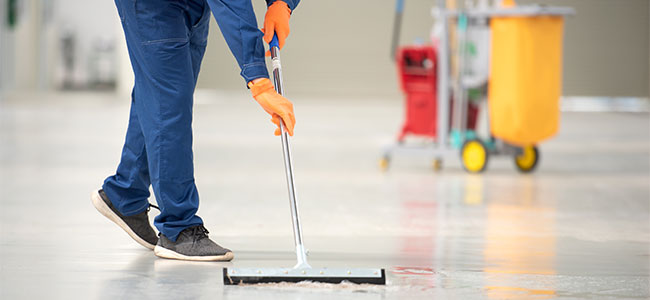
Tackling Slips, Trips and Falls
Some of the most common workplace injuries are caused by slips, trips and falls. How do safety managers identify their causes and implement effective solutions?
Employee safety is one of the most important aspects of any workplace, yet every facility experiences slips, trips and falls. Being able to identify possible hazards can improve employee safety, reduce the chance of costly fines and prevent downtime due to injury.
According to the Bureau of Labor Statistics, some of the most common workplace injuries are caused by slips, trips and falls¹. In fact, these workplace injuries are the third most common behind overexertion and contact with objects and equipment. Since this is one of the most common paths to injury, it’s no surprise that OSHA has a dedicated standard to help prevent such incidents. The OSHA 1910.22 general requirements for walking-working surfaces address the hazards associated with slips, trips, and falls.
OSHA’s definition of a walking-working surface is “any horizontal or vertical surface on or through which an employee walks, works, or gains access to a work area or workplace location.” OSHA regulations require that these surfaces:
• Must be clean — 1910.22(a)(1): All places of employment, passageways, storerooms, service rooms, and walking-working surfaces are kept in a clean, orderly, and sanitary condition.
• Must be dry — 1910.22(a)(2): The floor of each workroom is maintained in a clean and, to the extent feasible, in a dry condition. When wet processes are used, drainage must be maintained and, to the extent feasible, dry standing places, such as false floors, platforms, and mats must be provided.
• Must be free of foreign hazards — 1910.22(a)(3): walking-working surfaces are maintained free of hazards such as sharp or protruding objects, loose boards, corrosion, leaks, spills, snow, and ice.
While these are some of the most important regulations for walking-working surfaces, OSHA has more in-depth directives, too. It’s important for you and your employees to be familiar with these regulations to help stay in compliance and reduce the likelihood of a slip, trip, and fall.
Identifying causes of slips, trips and falls
Unlike most industrial injuries, slips, trips, and falls can happen to any employee, visitor, or contractor at your facility. Identifying hazards is sometimes difficult because they can occur at any location and come from many sources. It’s important to inspect all areas of a facility, both indoors and outdoors, on a regular basis. It’s also a requirement by OSHA 1910.22(d)(1) which states, “Walking-working surfaces are inspected, regularly and as necessary, and maintained in a safe condition.”
One of the keys to addressing slip, trip, and fall dangers is knowing what causes them. The most common origins are:
• Wet or oily floors: Washdown bays, overspray from spray booths, spills in liquid storage or filling areas, and machine leaks
• Uneven floors: A variation of ¼ in. or more on a walking/working surface which can be caused by worn, weathered, or damaged flooring
• Obstructed walkways: Objects stored in walkway, cords or hoses left in walkway, or doors and drawers left open
• Floors and surfaces with low coefficient of friction: Smooth surfaces, loose debris, and wet floors
Cost of slip, trip and fall injuries
If a slip, trip, or fall injury occurs, expenses like OSHA fines and workers’ compensation claims can add up quickly. To assign real-world dollar values, the maximum OSHA fine for a serious violation is $15,625, and according to the National Council on Compensation Insurance, the average workers’ compensation claim for a slip or fall was $49,971 in 2021. Indirect costs such as reduced productivity or lost work time can also be associated with slips, trips, and falls.
Solutions
There are many solutions to help eliminate slip, trip, and fall hazards. Some of the most widely used include:
• Cleaning up spilled liquids with spill kits. Typically, a kit should be stored as close to a liquid storage area as possible. If the liquid source moves, it’s best to store the kit near drains or other heavily trafficked areas.
• Employing items that add traction. Low traction is one of the most dangerous slip, trip, and fall hazards because it’s difficult to identify. Liquid, debris, and worn surfaces can all lead to a reduced coefficient of friction (CoF) which is the amount of friction between two surfaces. Slips and falls happen when the CoF between two surfaces is insufficient. Proper footwear, drainage mats, absorbent adhesive-backed mats, and textured floor surfaces can increase CoF.
• Signify designated areas with floor marking tape. Objects such as boxes, tools, cords, and other clutter can lead to an incident, so floor marking tape can be used to clearly identify walkways and help prevent employees from placing items in those areas.
• Drawing attention to high-risk areas with floor signs. Sometimes eliminating slip, trip, and fall hazards isn’t possible. If you have problem areas where hazards happen often, it’s important to highlight the danger. Wet floor signs or other marking devices can be used to bring attention to these hazards.
• Using proper weather control procedures. Most facilities will see rain or snow throughout the year, and that can cause hazards at entryways. Entrance mats, floor drying fans, and ice/snow control can help reduce these issues.
While the severity of a slip, trip, and fall hazard can vary, it’s important to identify and correct the hazard immediately. Slip, trip and fall prevention is a constant battle that requires continual vigilance to identify potential hazards and quickly rectify them. Maintenance of a safe walking-working surface will take time and resources, but that’s a small price to pay compared to the risk of employee safety, steep fines, and reduced production.
This article originally appeared in the April/May 2024 issue of Occupational Health & Safety.